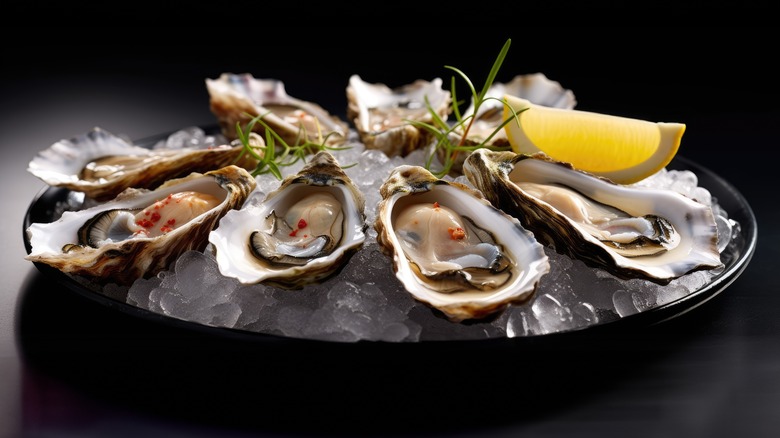Why You Need To Be Careful With Restaurant Oyster Deals
The idea of eating oysters can be intimidating for the uninitiated, but humans have enjoyed this succulent shellfish since as far back as the Stone Age. Many societies have dined on this ocean-dweller since the first ones were slurped down — most notably, the Greek and Roman empires. However, if you want to enjoy a few oysters at a fancy dinner, you should proceed with caution.
Though oysters are a delicacy, seeing them featured as part of a restaurant deal should raise red flags for you as a consumer. At many eateries, oysters aren't going to be a primary focus or even a particularly popular option. Often, these restaurants will create an oyster deal to get rid of shellfish that has been sitting in a chiller for a little too long. According to the CDC, it is safe to eat oysters raw, but the fact that this seafood doesn't need to be cooked makes minding its source for your safety all the more important.
Beware of bargain bin oysters
If you sidle up to the bar at an establishment that prioritizes its oysters, the shellfish you're tossing back will probably be fresh. Oysters actually have a longer shelf life than other shellfish. The Washington State Department of Health tells us that oysters, as they have a sealed shell, can be kept in refrigeration for up to a week, whereas unsealed shellfish like softshell clams will only last three or four days. A specialist oyster bar likely receives shipments of fresh oysters every other day, as the restaurant might go through upwards of a thousand oysters in a single night. This consistent turnover is usually an indication that the oysters you're eating are safe.
Fortunately, there is a rather obvious visual clue to a restaurant's level of oyster expertise. If a restaurant knows how to properly shuck raw oysters, it can be a sign that the eatery goes through many of them, and as a result, the staff will be more aware of how to serve safe shellfish. Though presentation doesn't guarantee oyster freshness, it can be an indicator of the restaurant's due care and attention.
The health risks of slurping on shellfish
The most common infection associated with eating raw oysters is vibriosis, which infects around 80,000 people every year, and for roughly 100 of these victims it's fatal, says the CDC. Vibriosis can be contracted by simply coming into contact with brackish or saltwater contaminated with Vibrio bacteria, but the majority of cases come from consuming undercooked shellfish.
Eating raw oysters is a common practice, but it will never be perfectly safe. There's a lot of misinformation about raw oysters, and the FDA dispels some of these false claims. A commonly reiterated and scientifically unsound piece of advice is to avoid eating oysters in months that do not contain the letter "R". There is some sense to this. It does filter out the warmer months when Vibrio bacteria are more prevalent, but it's actually safe to eat oysters in July. As many as 40% of vibriosis cases pop up in the colder months, September through April, the FDA says. It's also important to understand that a contaminated oyster cannot be identified from safe shellfish and that neither hot sauce nor alcohol — which are sometimes cited as anti-contaminants that you can pair with oysters to ensure your safety — can kill Vibrio bacteria. Don't let these potential risks put you off enjoying oysters, but you should proceed with caution before eating raw shellfish.


